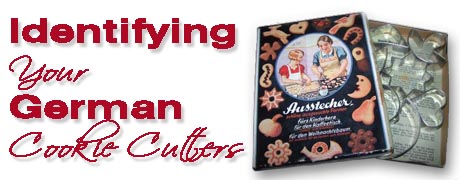
by Phyllis Wetherill
Probably no other country has as extensive a cookie making history as Germany.
Today’s Germany is a country reunited and a country whose boundries have changed more than once in the last century. Many of the comments here apply also to countries which, at one time, belonged to Germany or were populated by Germans. These areas include the Alsace, Austria, Czechoslovakia and Poland. Similaries exist also in Switzerland and Belgium.
150 years ago, Germany consisted of small city states and principalities each of which had its own customs and traditions. When Germans left the area of their birth, they carried their customs with them. The ninteenth century saw Germans emigrating to the United States in great numbers. Like other immigrant groups, they clustered together and created new German communities which differed from those in Germany because there was often a mixing of Germans from different areas in the Fatherland.
An example of this kind of migration is the Penn Dutch people in Pennsylania and in Canada. Anyone who reads W.W.Weaver’s book on Penn Dutch cooking will note that even when recipe names are the same, the end of the 20th century German cooking and baking is different from Penn Dutch foods.
Importing all manner of equipment from Germany became a lucrative business because so many things that people loved and wanted had been left behind. Importers bought in Germany and through wholesale distribution. While this was happening, manufacturing companies in the United States began making similar items locally. Referring to wholesalers and manufacturers of cookie cutters, one notes that many have German names: Thurnauer, Kreamer, Fries, Maier in several forms and many more.
Numerous museum store items have to do with shaping dough. By 1550, and probably before, regions made specific kinds of cookies with special recipes. Nurnberg was known for its lebkuchen, areas in Southern Germany for springerle, Aachen for printen, Appenzell for bieber and Zurich for tirggel. Museum holdings emphasize these differences although most museums have samplings of implements from other countries, sometimes including the United States.
Large (or small) cookies imprinted by carved wooden boards (molds) were usual in Germany and surrounding countries. Some boards had intensely religious motifs, the Crucifixion for example. Others contained portraits and crests of wealthy families. Some illustrated a point of view or a popular scene. Very large cookies were eaten by a family or a group of people.
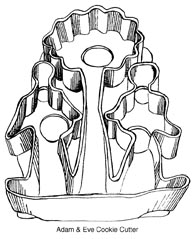 The use of cookie cutters came later, or so the books tell us. What about the Adam and Eve cutter shown here? Were there other cutters of that period which have not survived? Is the identifying information incorrect? The use of cookie cutters came later, or so the books tell us. What about the Adam and Eve cutter shown here? Were there other cutters of that period which have not survived? Is the identifying information incorrect?
Carved wooden molds dominated cookie making for several hundred years Dozens of books have been published on this subject and are still being published in Europe. European Museums give far more space to carved wooden boards than to cookie cutters. Finding cookie cutters in European museums is difficult. No one knows much about the half dozen cutters they have, nor do they care. Wooden molds are catalogued with similar numbers and are kept together on the shelves. Not so with cookie cutters. In one museum, the staff knew they had cookie cutters, but they were scattered in the catalog and on the shelves with no way to retrieve them.
Carved molds can print a scene in a particular geometric shape. The finished product will resembed a matted drawing. Sizes vary from 1/2" to 4’ x 6’ square. An example is the Cruxification mentioned above. The Cruxifiction would have been carved in the center of a board. When baked and decorated, it would appear in the center of the dough square. A woodcut survives showing a family passing the “cookie” from person to person, each breaking off a piece.
Molds can be used to make a cookie in the shape of the picture on the mold. A mold with the imprint of a dog can be cut out of the surrounding dough to make the dough square. The shape of a dog can be imprinted by a mold and then cut to make a dog cookie without a margin.
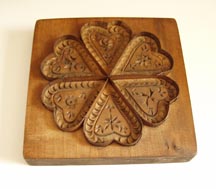 Was there a transition from carved wooden cookie molds to metal cookie cutters? When the time and skill necessary to carve wooden molds became scarce, cutters may have been used as a sort of necessary evil. The carved pictures on some molds are bounded by strips of metal. Such molds cut the cookie at the same time they imprint it. Was this a transitional form from molds to cookie cutters? One might think so, but one does not find such wooden-metal forms in most areas. Did metal outline cutters arise spontaneously in many parts of Europe as a necessity when time was limited? More research is needed before these questions can be answered. Was there a transition from carved wooden cookie molds to metal cookie cutters? When the time and skill necessary to carve wooden molds became scarce, cutters may have been used as a sort of necessary evil. The carved pictures on some molds are bounded by strips of metal. Such molds cut the cookie at the same time they imprint it. Was this a transitional form from molds to cookie cutters? One might think so, but one does not find such wooden-metal forms in most areas. Did metal outline cutters arise spontaneously in many parts of Europe as a necessity when time was limited? More research is needed before these questions can be answered.
The manner of baking imprinted shapes as it is done in Dinant, Belgium, is interesting. Dough is rolled to the correct thickness for the mold which is to be used. The larger the mold, the thicker the dough. Cookies are first cut with a cutter which is the same shape as the mold to be used. The cookies are then put one by one into the mold, pressed, taken out and put on a cookie sheet where they sit for awhile before being baked.
In the United States, fable, if not fact, tells us that itineret workers went from door to door, making tin items of use to a housewife. There is truth to this, but it is not as universal as some would have us believe. Early American cutters were made in New England and in Pennsylvania and spread out from there. Tin scraps were used by some but not all tinsmiths. For whatever reason, only a small number of cutters made in Germany had backs. The back became usual in America. Why? And why were there so few wooden molds carved ?
Judging from a study of old cookie cutters, uniform blanks may have been used by some American tinsmiths. They were thin pieces of tin cut in a rectangular shape of a standard dimension. Because one finds so many similar but not quite identical old-but-not-great cutters, animal patterns may have been used by many tinsmiths or small factories. Germans had blanks too, much heavier than the American tin backs. Theirs were often too small to cover the entire cutter. Some parts of the cutting edge were outside the rectangular back.
Some German cutters are very heavy. Many made a century ago show little wear and will last for a few more centuries. However, not all German cutters are heavy. Many braced outline cutters of a hundred years ago are poor in construction; few bakers would consider using them today.
German cutters which are strong and which have braces or a metal rectangle which does not cover the entire cutter hint about their origin. What else distinguishes German cutters?
Another consideration in determining whether a cutter is German is the subject matter of the cutter. Germans do not have the same fascination for something new and different that Americans have. One is not likely to find variety in cutters offered for sale. For many, the old classical forms are exactly what are wanted. In many households, cutters have been handed down through generations. When they are not, identical cutters can be purchased.
A typical group of inexpensive German plastic outline cutters from 1980 include rabbit, pig, pear, chimney sweep, horseshoe, heart, mushroom, 6 point star and circle. The combination of a pig, pear, chimney sweep, horseshoe and mushroom in one set is a clue.
The form of the heart used to be a clue. European hearts often had a thinish tail. Because tinsmiths in the United States are now making hearts like this, the difference cannot be used to guess about the origin of a heart cutter.
In Europe, the chimney sweep has been the subject of cookie making for centuries in several countries. Many have made chimney sweep molds. The best present-day chimney-sweep cutters come from Austria. In the United States, Fox Run makes a chimney sweep cutter; many bakers cannot identify the shape. The chimney sweep is a symbol of good luck, used especially at the new year.
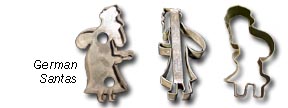
The differences in Santa shapes are several. European Santas (people too) are often shown in profile. Santas carry bags on their backs and may be bent from the heavy load. Santas with trees, formerly a decisive clue, has been copied by American cutter designers.
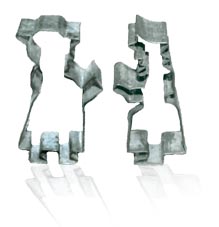 A pair of cutters has been of great interest as it turns up repeatedly in the United States. Tens of thousands of outline cutters in the shapes of a little man and a little woman have mystified collectors for years. Typically the man has a short coat, and the woman, a long coat. The woman’s hat is strange, at least to our thinking. One can find such hats on women in some Swiss schernesnitte cuttings. A pair of cutters has been of great interest as it turns up repeatedly in the United States. Tens of thousands of outline cutters in the shapes of a little man and a little woman have mystified collectors for years. Typically the man has a short coat, and the woman, a long coat. The woman’s hat is strange, at least to our thinking. One can find such hats on women in some Swiss schernesnitte cuttings.
We know that at least some of these cutters have been made in Germany because they are signed. They were probably made in 1906 or later.We know that some were imported by the S. Joseph Company. We also know that one appeared in a 1929 children’s magazine.
Many people call the man a preacher. Both the man and woman have hands in front of them. Were these cutters meant to illustrate characters in a story? Did German peasants dress this way? Are the cutters common to any specific area in Germany? If the man was shaped to be a preacher, he might be a parson in the Reformed Church tradition. But how does one explain the woman’s hands?
If one goal is to have an idea about the country of origin of a cookie cutter, judging from its shape and construction, one must handle many cutters and look at cutter pictures in books and museums. Such acquaintance with design would be useful in realizing, for example, that the Allstar-Hutzler Santa cutter had been designed in Germany?” This particular cutter blurs differences between German and American shapes. An earlier example is the 8 point star which the Amana Colony in Iowa used repeatedly. This shape is also one of the cutters in the Allstar-Hutzler set.
Without question, German immigrants dominated the cookie shaping industry in the UnitedStates at least until 1925 if not longer. Which cutters were made in Germany and which were made in the United States? The cutters must have seemed as intermingled then as the Hutzler-Buchsteiner and Gerdes rollers and cutters do today.
|

